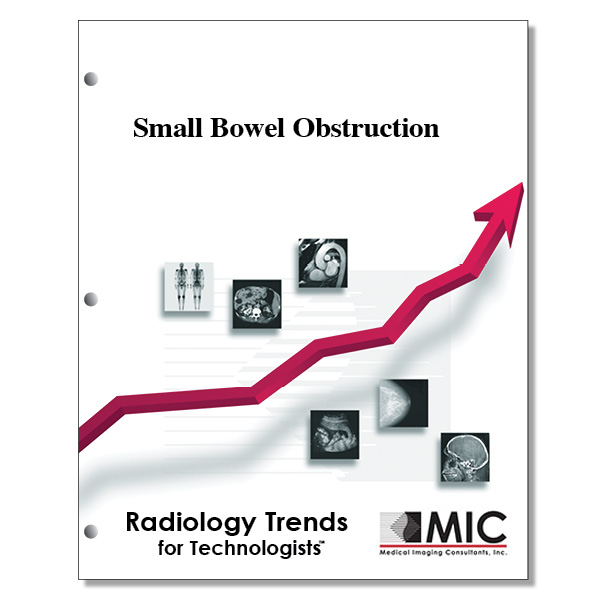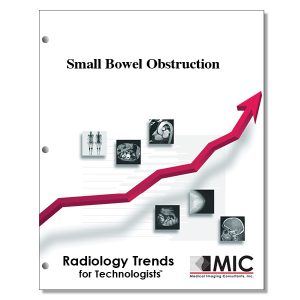

Small Bowel Obstruction
The pivotal role of radiology in recognizing, classifying and answering specific questions that will directly affect the management of patients with small bowel disease.
Course ID: Q00299 Category: Radiology Trends for Technologists Modalities: CT, Nuclear Medicine, Radiography, Sonography2.25 |
Satisfaction Guarantee |
$24.00
- Targeted CE
- Outline
- Objectives
Targeted CE per ARRT’s Discipline, Category, and Subcategory classification for enrollments starting after February 8, 2023:
[Note: Discipline-specific Targeted CE credits may be less than the total Category A credits approved for this course.]
Computed Tomography: 2.25
Patient Care: 0.50
Patient Interactions and Management: 0.50
Procedures: 1.75
Abdomen and Pelvis: 1.75
Radiography: 2.25
Patient Care: 0.50
Patient Interactions and Management: 0.50
Procedures: 1.75
Thorax and Abdomen Procedures: 1.75
Registered Radiologist Assistant: 2.25
Patient Care: 0.50
Pharmacology: 0.50
Procedures: 1.75
Abdominal Section: 1.75
Sonography: 1.00
Procedures: 1.00
Abdomen: 1.00
Radiation Therapy: 1.50
Patient Care: 0.50
Patient Interactions and Management: 0.50
Procedures: 1.00
Treatment Sites and Tumors: 1.00
Outline
- Introduction
- Imaging Work-up: Algorithmic Approach
- Findings at Plain Abdominal Radiography
- Findings at Sonography
- Findings at Multidetector CT
- Is the Small Bowel Obstructed
- How Severe Is the Obstruction
- Where Is the Transition Point
- What Is the Cause of the Obstruction
- Intrinsic Causes of SBO
- Disease
- Neoplasia
- Intussusception
- Radiation Enteritis
- Hematomas
- Vascular Causes
- Extrinsic Causes of SBO
- Hernias
- Endometriosis
- Intraluminal Causes of SBO
- Ileus
- Bezoar
- Distal Intestinal Obstruction Syndrome
- Other Intraluminal Casues
- Intrinsic Causes of SBO
- Is the SBO Simple or Complicated
- Conclusions
Objectives
Upon completion of this course, students will:
- define small bowel obstruction
- know the questions radiology answers pertaining to SBO
- understand the typical first step in diagnosing SBO
- recognize limitations of sonography for assessing SBO
- learn the roles of each modality and understand which one excels for identifying strangulation
- recognize the signs and symptoms of a small bowel obstruction
- understand how often conventional abdominal radiography is non-specific and misleading for SBO
- learn when immediate surgical evaluation should be performed on SBO
- learn which patient population would benefit from CT enteroclysis
- understand the sonographic criteria to identify SBO
- learn which study is best for examining SBO associated with external hernia
- understand why multidetector CT plays a primary role in small bowel obstruction
- realize the questions multidetector CT can answer pertaining to SBO
- know the criteria that define a dilated bowel loop in CT
- learn the defining criteria and be able to recognize a high-grade obstruction
- learn how the effects of time affect the distal segment of a high-grade obstruction
- learn how positive oral contrast is used to grade the severity of an SBO
- define the transition point and understand how to identify it
- be familiar with the “small bowel feces” sign
- define the different types of small bowel obstructions
- understand how endoluminal obstructions can occur
- identify the top causes of SBO in Western society
- identify intrinsic causes of SBO
- be familiar with how often small bowel neoplasms are involved in SBO
- be familiar with radiation enteritis and its resulting effect
- identify extrinsic causes of SBO
- be familiar with gallstone ileus
- be familiar with the appearance of intraluminal obstructions
- be familiar with some of the causes of small bowel obstruction in children
- recognize what pneumatosis inestina, and the halo sign are indicative of
